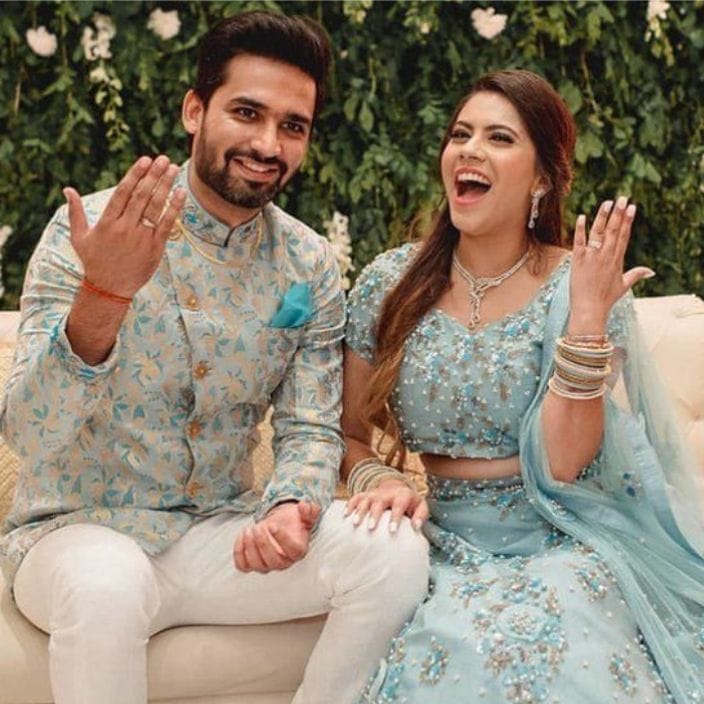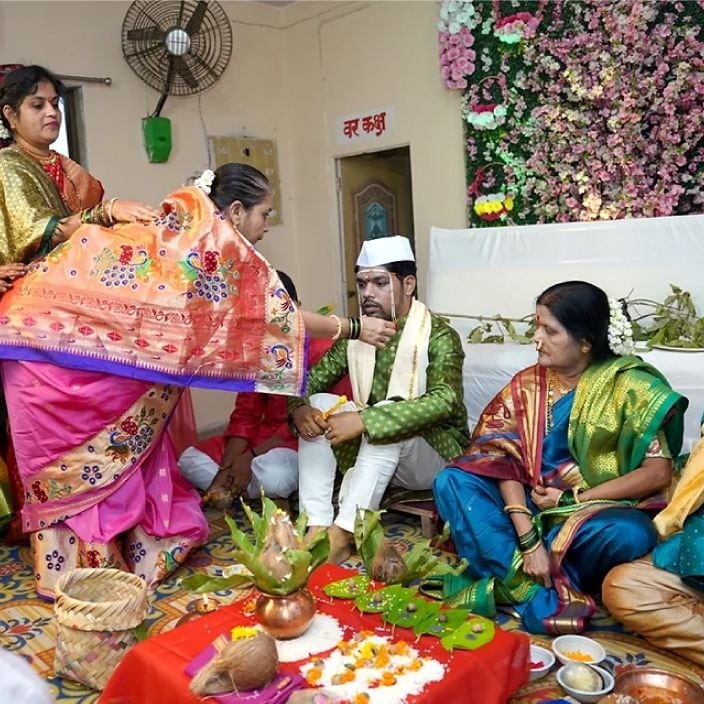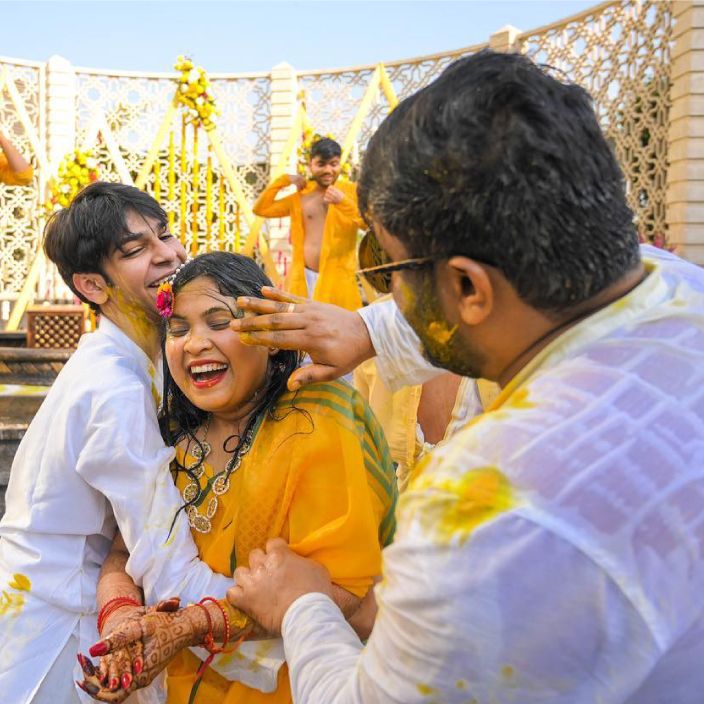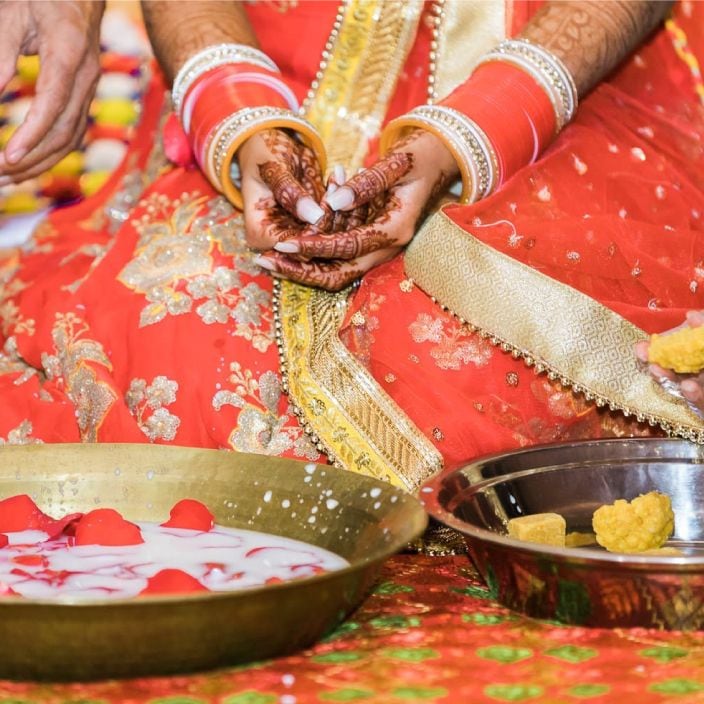For best prices and early deliveries, WhatsApp us at. 918488070070
Maharashtra
Maharashtrian weddings are simple and heartfelt affairs rooted in age-old traditions. Maharashtra has a rich history and is particularly known for the powerful Maratha Empire started by Shivaji Maharaj. Under his rule, Hindu culture flourished and permeated everything from literature to architecture to weddings. The colonial era ushered in an era of cultural fusion, resulting in a modern Maharashtra where traditional values exist amidst modernity. Hindus make up the majority of the population, followed by Muslims, Buddhists, Jains, Christians, Sikhs, Jews, and Zoroastrians. The Hindu Maharashtrian community is made up of several castes, such as Marathas, Kunbis, Kolis, and Saraswats. Hindu wedding traditions vary slightly in each community and across the state’s major regions: Konkan, Paschim Maharashtra, North Maharashtra, Marathwada, and Vidarbha. But overall, they follow similar customs and ceremonies as explained in the Vedic scriptures. Most Maharashtrian weddings will have Sakhar Puda or the Engagement ceremony, and the Halad Chadavane, the Haldi ceremony. Many of the rituals also give a lot of importance to Lord Ganesha, Maruti, Lord Vitthal, and Goddess Gauri. The weddings are beautiful celebrations focused on the couple and their families, bringing together lots of love and warmth to the traditions.
Tracing the Traditions
Before a Maharashtrian wedding begins, there are a series of pre-wedding rituals. These serve different purposes, including following tradition, bringing good luck, and preparing the bride and groom for marriage. It starts with the Lagnaach Bedior, an event where a family priest matches the kundalis or horoscopes of the couple. By doing so, the priest finds an auspicious date and time for the wedding.
Once given the go-ahead, the family arranges the official engagement ceremony called Sakhar Puda. During this function, the groom’s parents give a packet of sugar (Sakhar) to the bride, and the bride's parents give a coconut and coin to the groom. This is an official acceptance of the wedding by the two families. The couple also exchanges engagement rings and more gifts of sarees, jewellery, and Haldi-Kumkum are given to the couple.
Another important pre-wedding ritual is the Muhurt Karane, where the bride’s family invites five married women to help with the wedding preparations. They perform various tasks, such as making turmeric powder and Sandege (spice powder), rolling papads, and shopping for bridal attire and jewellery.
Just a few days before the wedding, both families pray to their family god or Kuldevta in a pooja called Kelvan. The family may also host Halad Chadavane, a Maharashtrian version of the Haldi ceremony, where they apply turmeric paste on the bride and groom for good luck.
The wedding itself is filled with sacred rituals and customs. Most weddings start with a Ganpati Puja, followed by the Devdevak and Gaurihar Pooja. The Devdevak Pooja invites the Kuldevta to bless the mandap, while in the Gurihar Pooja, the bride prays to Goddess Parvati for prosperity and good fortune. Other rituals include Punyavachan and Seemanpuja.
When the groom enters the mandap, a curtain, known as Antarpat, is held in front of him. Then the bride enters during the Sankalp, the Antarpat is removed, and the couple exchanges garlands. The father of the bride gives her away during Kanyadaan, after which a sacred fire is lit during Lajahoma as the couple chants mantras with the priest. The groom ties the mangalsutra around the bride’s neck and puts Sindoor (vermillion) on her forehead. They take seven circles around the fire during Saptapadhi, where each circle represents a vow.
The mandap rituals conclude with Karmasamapti, during which the couple prays to Goddess Laxmi until the fire goes out. The bride leaves the wedding venue during Varat, the emotional Bidai ceremony. As she leaves for her husband’s home, the groom carries the Parvati idol from the Gaurihar Puja. At the groom’s home, his family welcomes the couple with a Grihapravesh Aarti, and the bride gently kicks a kalash of rice for good luck. The final celebration is a wedding reception, where the bride and groom can enjoy a grand party with their family and friends!
Wedding Attire
In traditional Maharashtrian weddings, the groom wears an off-white, cream, or beige cotton kurta paired with a white kanche or dhoti with a thin gold border. To add a touch of colour to this elegant ensemble, he may wear a red or gold stole around his shoulders. He can also wear a classic Maharashtrian Pheta, a turban made by wrapping with a long, cotton cloth around the head. Traditional colours include saffron to symbolise valour and white to indicate peace. Some famous varieties include the Kolhapuri pheta, which comes in a bright colour with a Bandhani print, and the Puneri pheta which has checkered patterns with a distinct gold border. For ceremonies other than the wedding, the groom can wear a kurta set with a Nehru Jacket or Bundi coat, accessorised with a Gandhi-style hat.
The Maharashtrian bride is a picture of grace and beauty. She can wear a traditional six-yard Paithani or the nine-yard Navari saree. These silk sarees are luxurious and vibrant, often in red, yellow, orange, purple, and green colours with exquisite gold borders
Both Paithani and Navari sarees are known for their intricate look featuring peacock motifs, floral patterns, and geometric designs and draped in the typical Marathi dhoti style. She often carries a shela, a silk shawl or a stole that complements the bridal saree. It is draped elegantly behind the back to highlight its embroidery and the saree's pallu. Contemporary brides may opt for a contrasting colour or experiment with fabrics like velvet, tulle, or georgette.
For her bridal jewellery, the Maharashtrian bride wears classic gold ornaments. There are many traditional earrings, necklaces, armbands, and nose rings she can choose from. The Maharashtrian bride’s most recognisable accessories are her green glass bangles, Mangalsutra, Thushi and Kolhapuri Saaj necklaces, armbands, Brahmani Nath, and a moon-shaped Bindi. Both bride and groom wear a Mundavalya, a string of pearls attached to their headband.
Traditional Cuisine
Maharashtra cuisine is known for its spicy flavours and bold spices. The state has a long coastline, and the areas by the Konkan coast are known for their seafood dishes. Konkan cuisine is influenced by Malvani, Goud Saraswat Brahmin, and Goan cuisines. In contrast, inland areas such as Vidarbha have heartier vegetable-based offerings. Western Maharashtrian dishes feature a lot of peanuts, jaggery, curry leaves, and coconut.
Guests can enjoy vegetarian delights like Batata vada, Vada pav, puran poli, Ukdiche modak, Sabudana khichdi, Pav-bhaji, and masala bhat. These can be enjoyed along with pitla, bhakri, bharleli vangi, and aluchi patal bhaji.
While some families only serve vegetarian food at certain religious wedding functions, certain ceremonies will also have non-vegetarian options, such as sukka mutton, Pandhra rassa, and Tambda rasa.
For desserts, the wedding feast is incomplete without Modak, Puran Poli, Shrikhand, and Aamras. Sol Kadhi is also a favourite drink to accompany the meal, and Kothimbir Vadi adds a flavorful touch. Guests can indulge in Varan Bhaat and Poha, perfect for a hearty meal. The traditional Ukadiche Modak and Bhakarwadi are also served, completing the festive spread.
Cultural Decor
Maharashtrian wedding decor is colourful and classy. Whether the ceremonies are held in temples, banquets, or outdoors, the decor can range from grand and opulent to simple and elegant, depending on the couple’s taste. Much of the decor features fresh flowers, such as marigolds and roses, along with lush greens and palm leaves. These are strung in torans around the venue or placed in vases, symbolising vitality and good luck. Other traditional motifs such as peacocks, lotuses, and mangoes can be seen in the decor as well as they symbolise beauty, purity, and prosperity.
Traditional fabrics like Paithani silk, Mashru silk, and Khadi add a luxurious texture to the decor. Silk or embroidered drapes, often in red, yellow, and green, are used to drape the mandap to create a regal ambience.
Colours play a significant role in Maharashtrian decorations. Red symbolises prosperity and happiness, yellow represents knowledge and learning, and green stands for growth and prosperity. Contemporary couples may also opt for softer orange, pink, and ivory for a sweet, minimal look. Other modern elements include fairy lights, ornate lanterns, and peacock feathers.
As for traditional decor items, many weddings have idols of Lord Ganesh and Goddess Lakshmi placed at the entrance or near the mandap. You can also spot classic Maharashtrian brassware, including lamps and candle stands, as well as Peshwa chairs for the couple. Other Maharashtrian-style furniture, such as Diwan or wooden Jhoola (swing), can be used in the guest seating areas.





